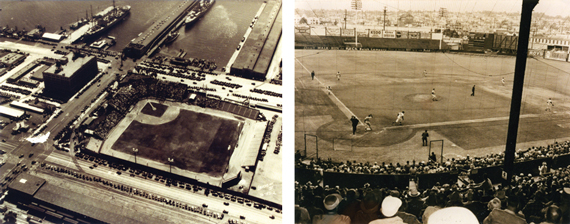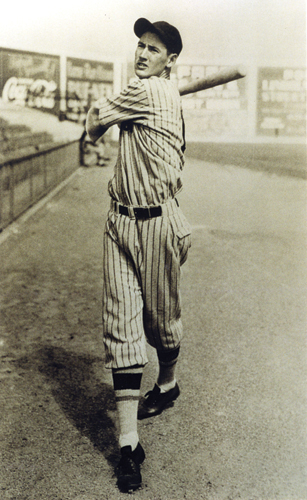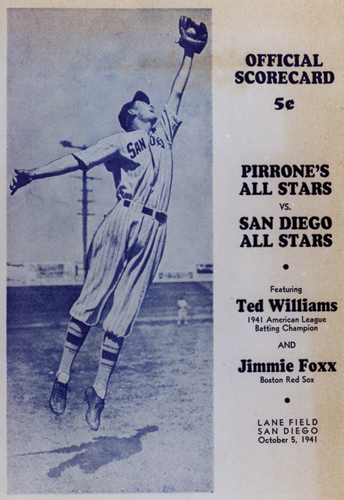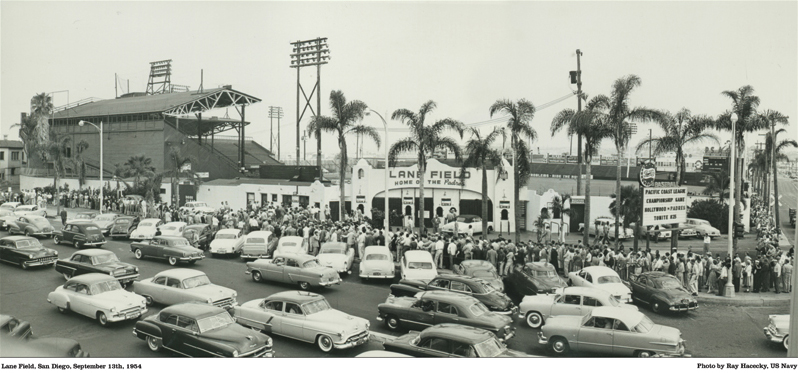|
Baseball Returns Downtown
By Bill Swank
"Baseball returns downtown" was the popular slogan of the San Diego Padres when Petco Park opened in 2004. The Padres marketing campaign was a tribute to old Lane Field, the original bay view home of the Pacific Coast League Padres who ruled the corner of Broadway and Pacific Highway for 22 seasons.
When team owner Bill Lane signed a contract to relocate his Hollywood Stars to San Diego on January 28, 1936, there was no suitable venue for professional baseball. In a remarkable example of cooperation between government agencies and private enterprise, Lane Field was built within two months for approximately $25,000 by the Works Progress Administration (WPA). The first game was played on March 31, 1936. The Padres beat the Seattle Indians, 6-2, before 8,178 cheering fans.

Lane Field in 1936 before the roof was completed; Lane Field in the 1950s after the leftfield bleachers were condemned.

Young Padres slugger Ted Williams at Lane Field (1936-1937).
|

Scorecard from 1941 barnstorming game played at Lane Field featuring Ted Williams on the cover.
|
Native son Ted Williams's first memory of the Padres was watching them play at Lane Field through a knothole in the centerfield fence. By the end of that inaugural 1936 season, young Ted would become the team's starting leftfielder. During the Great Depression, ballplayers were forced to find jobs during the off-season, but not Williams, he returned to Hoover to complete his senior year of high school. In 1937, the Padres won the Shaughnessey Playoffs and were crowned PCL Champions. The love affair between San Diego and the Padres was the real thing. That winter, The Kid was sold to the Boston Red Sox where he became one of baseball's immortals.
Over the years, other prominent left-handed sluggers, Max West, Jack Graham and Luke Easter, launched home runs onto Pacific Highway. Graham noted, "I was a dead pull hitter and the wind blew off the bay to right. They'd fly out."
There is a legend about the world's longest home run. A Pacific Coast League baseball apparently bounced on Pacific Highway and landed in an empty boxcar near the Santa Fe Depot. The ball was later found in Los Angeles, 120 miles away, making it the longest home run ever. Who hit it?
Over the years, this home run has been attributed to Williams, West, Graham or Easter, but banjo hitting first baseman George McDonald claims he is the man. I like to tell people that George became a used car salesman and later a highly successful auto dealer.
In 2003, this feat, along with a description of the ballpark, was commemorated on a bronze plaque dedicated by the local Ted Williams Chapter of the Society for American Baseball Research (SABR) and the Port of San Diego. The plaque can be viewed on a small, pie-shaped parcel of grass and palm trees at the intersection of Pacific Highway and Broadway.
This hallowed ground, carved out by a railroad track leading to the docks, is the only remaining trace of Lane Field. In 1958, the termites chased the Padres to Westgate Park in Mission Valley. The decaying green grandstand, condemned bleachers and fading outfield fences were razed at that time. The site has remained a parking lot for almost fifty years.
When former Lane Field Padres Pete Coscarart and Tony Criscola were interviewed in 1995, both described playing in San Diego as "paradise." At the time, their description reminded me of the chorus from Joni Mitchell's song, Big Yellow Taxi, "They paved paradise and put up a parking lot." Such valuable property could not remain dormant forever, so, all together, let's sing the next verse. "...with a pink hotel, a boutique and a swinging hot spot."
A new high-rise hotel is currently on the drawing boards. I believe in progress, but I hope a small pie-shaped piece of paradise will be preserved to honor the memory of Lane Field...a swinging hot spot.

Crowds line up for 1954 playoff tickets in panoramic view of Lane Field taken by Navy photographer Ray Hacecky.
Bill Swank is San Diego's preeminent baseball historian. He has authored or co-authored six previous books,the award-winning "Echoes from Lane Field, the story of the original 1936 Pacific Coast League Padres," and his most recent two-volume work, "Baseball in San Diego: From the Plaza to Petco," covers the journey of baseball from Horton Plaza to Lane Field (1871-1936).
|
MORE FROM THIS ISSUE
The Broadway Fountain
San Diego's Historic Warehouse District
Just the Facts
National City & Otay Railroad Depot
The Inside Story
2007 Most Endangered List
Sim Bruce Richards
2007 People In Preservation Award Winners
Baseball Returns Downtown
Reflections
Lost San Diego
Strength in Numbers
Advertisements
DOWNLOAD full magazine as pdf (24mb)
|







